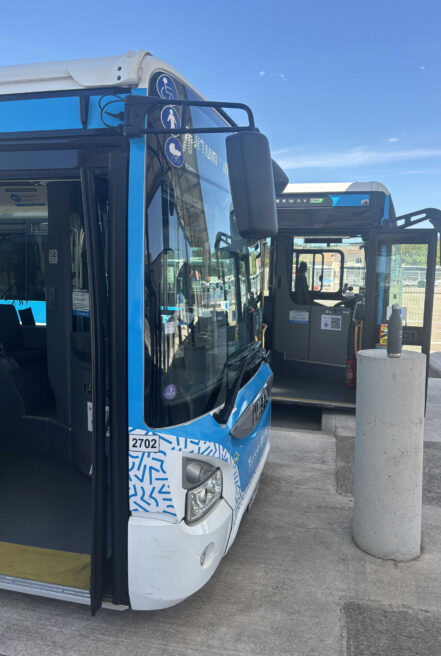
FEEDBACK FROM AURÉLIEN MARCON-BLACHE, IT MANAGER FOR THE TOUT’ENBUS NETWORK
Aurélien Marcon-Blache, IT Manager for the Tout’enbus network in Aubenas, shares his experience with the technological evolution of the transport system. Since 2019, he has been improving mobility by using onboard systems and digital tools to simplify and optimize passengers’ journeys.
Aurélien, can you introduce yourself ?
I'm Aurélien, and I'm in charge of route and schedule planning, onboard systems, communications, and network operations control for the Tout’enbus network in Aubenas.
How long have you been working for the Communauté de Communes du Bassin d’Aubenas ?
I’ve been working there since January 2019.
And what did you do before that ?
Before, I was a bus driver for 13 years on an urban network in Valence, in the Drôme region, as well as for other operators. Although I didn’t study transportation specifically I have a high school diploma in electronics and a two-year technical degree (DUT) in computer network telecommunications my passion for buses goes back to childhood. I’ve been fascinated by buses since I was 10 years old, and today, I’m lucky enough to have made it my career.

Does the service offering change regularly to better meet demand ?
The service is partially updated in September, but adjustments are also made throughout the year. For example, we can change a schedule in response to a request or a GTFS update. So it’s never set in stone.
I work to improve mobility within the Communauté de Communes by using new technologies and analyzing passenger numbers to adjust routes and meet users’ needs. My goal is to simplify certain lines or routes that might seem complicated in terms of schedules and clarity for users.
What is your role today at the Maison de la Mobilité in Aubenas ?
Is there also a difference in the service between the summer season and the rest of the year ?
No, the base schedule for the lines stays the same all year. Some trips run only during the school term, and a few are suspended on Saturdays during school holidays. We also have a summer shuttle that runs on Sundays and public holidays during the summer.

You’ve been fully digitizing since 2020.
Do you still use paper guides ?
The goal is to digitize them and only print on demand. For now, we still keep paper guides available, and we review the stock at the end of the year to adjust our approach accordingly.
What new technologies have you implemented to improve mobility?
Hubup is already a great example: this tool helps drivers by clearly showing stops, schedules, and whether they’re running early or late. By entering their route, they can see their entire shift for the day, which helps reduce mistakes.
Beyond digital tools, I’ve also introduced laminated route sheets to give drivers a clear overview of their day, and I make sure all signage is easy to read.
On the digital side, several projects are underway, including a website redesign to enhance the passenger experience.
Even before the LOM law came into effect, we were already sharing our data both real time and static GTFS on the national access point. Our schedules are available on Google Maps and shared through Hubup, MyBus, and Transit, which makes information more accessible, even if our audience often older is still getting used to these tools.

Do you see any change in the number of printed schedules distributed over the past few years ?
In your opinion, is it necessary to have access to this information ?
believe it’s essential to have quick and reliable access to this information. It reassures users to know that the information they consult is accurate and up-to-date, especially regarding bus schedules and travel details. The region already offers the Oura app, which covers all transport networks in Auvergne-Rhône-Alpes, including Tout’enbus. We also recommend users download our Hubup app.
Thank you, Aurélien, for sharing your experience, and thanks to the Tout’enbus teams for their trust !
We wish them all the best on the road.

I feel like we’ve distributed a lot fewer this year. Yet, ridership hasn’t decreased. More and more users check schedules online, and with the growing number of tools available to find this information, the paper schedule is gradually becoming obsolete. If we notice a significant drop in stock, we might consider switching entirely to digital versions. We still provide schedules by phone, but requests are decreasing as people become more independent. Our role at the Maison de la Mobilité is precisely to help users become self-sufficient.
